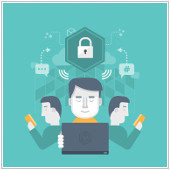 Is your Android phone or tablet acting strange? Is it running slower than usual? Is it consuming a lot of mobile data fast? If any of these instances sound familiar, your device may be infected with a virus. This guide will show you how to get rid of malware in your Android device.
Is your Android phone or tablet acting strange? Is it running slower than usual? Is it consuming a lot of mobile data fast? If any of these instances sound familiar, your device may be infected with a virus. This guide will show you how to get rid of malware in your Android device.
The lowdown on Android viruses
A virus infection on Android devices is actually incredibly rare. Seeing pop-up ads prompting you to buy a virus removal app doesn’t automatically mean your device is infected. In fact, buying one of these apps could get your device infected by a virus! That’s because all Android viruses are contracted via apps you install on the device. To avoid getting infected, install only apps from the Google Play app store. If you must buy one from third-party stores, do some research first.
If you suspect that your device has been infected, here’s what you can do:
- Use antivirus apps from Google Play or Google Play Protect – A lot of these are free and will detect and remove malicious apps, but some have a tendency to report apps as infected when they’re actually completely fine.
- Perform a factory reset – If a virus has infected your phone, this is a surefire way to remove it. However, in doing so you return your phone to its original factory settings. That means you’ll lose all data that you haven’t backed up.
If your device has been infected, here are ways to remove the virus.
- Turn safe mode on. To do this, access the power-off options by pressing the power button, then press and hold Power Off. This gives you the option to restart in safe mode. However, this doesn’t work with all Android phones or tablets. If it doesn’t work with your device, a quick Google search will pull up model-specific instructions. Turning on safe mode prevents any malware from running.
- Search for the infected app. Do this by opening Settings and then Apps. Check the Download tab (since the virus can only be something you’ve downloaded), and then start searching for the suspected app. If you don’t know the virus’s name, it’s likely something that looks suspicious.
- Uninstall the app. Yes, it’s really that simple. Just click on the suspected app and uninstall it. Then you’re done. But if the name of the app is grayed out and can’t be tapped, it means the virus has given itself Device Administration Status. In this case, follow the next three steps below.
- Remove Administrator status: Do this by tapping on Settings and Security, then Device Administrators. Simply uncheck the infected app and hit Deactivate on the next screen.
- Uninstall the app. When you return to the Apps menu, the infected app will no longer be grayed out. Simply uninstall it.
- Restart your device. This takes it out of safe mode. Now your phone will be protected from viruses.
Want more ideas for Android and IT security? Don’t hesitate to give us a call today.

 Your smartphone and/or tablet are essential to your day-to-day tasks. Should they get infected by viruses, would you know what steps to take? If you’re using an Android device, you’re in luck. This guide can help you remove viruses on your Android phone or tablet.
Your smartphone and/or tablet are essential to your day-to-day tasks. Should they get infected by viruses, would you know what steps to take? If you’re using an Android device, you’re in luck. This guide can help you remove viruses on your Android phone or tablet. It’s common for computers to get infected by viruses, but did you know that your tablet or smartphone is prone to viruses and other malware infections, too? If your device is acting funny, and you think that a virus is causing the problem, these information and tips might help.
It’s common for computers to get infected by viruses, but did you know that your tablet or smartphone is prone to viruses and other malware infections, too? If your device is acting funny, and you think that a virus is causing the problem, these information and tips might help. A data breach can happen to anyone, even to the most secure businesses or financial institutions — and cybercriminals could even attack your company’s network. How can you be sure your network is completely hacker-safe? As a business owner, you can’t afford a data breach, as it could cost you your clients and reputation. Employing strict security measures can make any cybercriminal think twice about trying to break into your network. Here are some tips to protect your corporate data.
A data breach can happen to anyone, even to the most secure businesses or financial institutions — and cybercriminals could even attack your company’s network. How can you be sure your network is completely hacker-safe? As a business owner, you can’t afford a data breach, as it could cost you your clients and reputation. Employing strict security measures can make any cybercriminal think twice about trying to break into your network. Here are some tips to protect your corporate data. You can’t afford to lose business data. It takes away the trust of your clients, leading to loss of revenue. Cybercriminals are here to stay, so it’s more important than ever to utilize tight security measures to keep your business data safe. Still, some hackers may have advanced cracking skills, or are really determined to break into your network, so it’s a good idea to use the following methods for safeguarding your corporate data.
You can’t afford to lose business data. It takes away the trust of your clients, leading to loss of revenue. Cybercriminals are here to stay, so it’s more important than ever to utilize tight security measures to keep your business data safe. Still, some hackers may have advanced cracking skills, or are really determined to break into your network, so it’s a good idea to use the following methods for safeguarding your corporate data. Some of the most well-known companies in the world have been victims of cyberattacks, including Sony Pictures, Home Depot, Adobe, and eBay. While major corporations are high-profile targets for hackers, small- and medium-sized businesses are not exempt, so they need to secure their networks and data. It may be difficult or impossible to undo any damage caused by cybercriminals, so it’s imperative for you to take certain steps to prevent it. Applying the following security tips can help guard your company’s data.
Some of the most well-known companies in the world have been victims of cyberattacks, including Sony Pictures, Home Depot, Adobe, and eBay. While major corporations are high-profile targets for hackers, small- and medium-sized businesses are not exempt, so they need to secure their networks and data. It may be difficult or impossible to undo any damage caused by cybercriminals, so it’s imperative for you to take certain steps to prevent it. Applying the following security tips can help guard your company’s data. Many business owners tend to ignore the server room or pretend that it doesn’t exist. But this won’t change the fact that it can wreak havoc on your electric bills. Before you suffer, read this article to lower your energy bills.
Many business owners tend to ignore the server room or pretend that it doesn’t exist. But this won’t change the fact that it can wreak havoc on your electric bills. Before you suffer, read this article to lower your energy bills.  Data centers can be costly, more so if they quickly drain your resources. How much do you spend on them every month? Don’t be afraid to calculate your expenses since there’s a lot you can do to keep costs under control. Here are a few suggestions to keep in mind.
Data centers can be costly, more so if they quickly drain your resources. How much do you spend on them every month? Don’t be afraid to calculate your expenses since there’s a lot you can do to keep costs under control. Here are a few suggestions to keep in mind.  Is your data center sucking you dry like a vampire? Many business owners would like to believe that the server room and data center don’t exist. But whether you acknowledge them or not, they could be eating up your resources every month. Here’s what to do to cut costs.
Is your data center sucking you dry like a vampire? Many business owners would like to believe that the server room and data center don’t exist. But whether you acknowledge them or not, they could be eating up your resources every month. Here’s what to do to cut costs.  In these times of internet fraud, phishing scams, and high-profile hacks, you can never be too careful. Even if you think you have enough precautions in place, it always helps to take another look at your online safety. Here are some browser extensions you can add to improve your online security.
In these times of internet fraud, phishing scams, and high-profile hacks, you can never be too careful. Even if you think you have enough precautions in place, it always helps to take another look at your online safety. Here are some browser extensions you can add to improve your online security.  Think you’ve got enough online security measures in place within your company? It’s hard to tell since you’ll never really know what the next malware or online scam will bring. Plus, it only takes one employee’s mistake to put the company in danger. It’s time to add another layer of online security using browser extensions.
Think you’ve got enough online security measures in place within your company? It’s hard to tell since you’ll never really know what the next malware or online scam will bring. Plus, it only takes one employee’s mistake to put the company in danger. It’s time to add another layer of online security using browser extensions. Protecting yourself, your employees, and your business when you’re using the internet is necessary if you want to remain safe, productive, and profitable. Given the proliferation of phishing attacks, hacks, and online fraud, we all need to ramp up our online security measures. Here are some ways to bolster security using browser extensions.
Protecting yourself, your employees, and your business when you’re using the internet is necessary if you want to remain safe, productive, and profitable. Given the proliferation of phishing attacks, hacks, and online fraud, we all need to ramp up our online security measures. Here are some ways to bolster security using browser extensions.